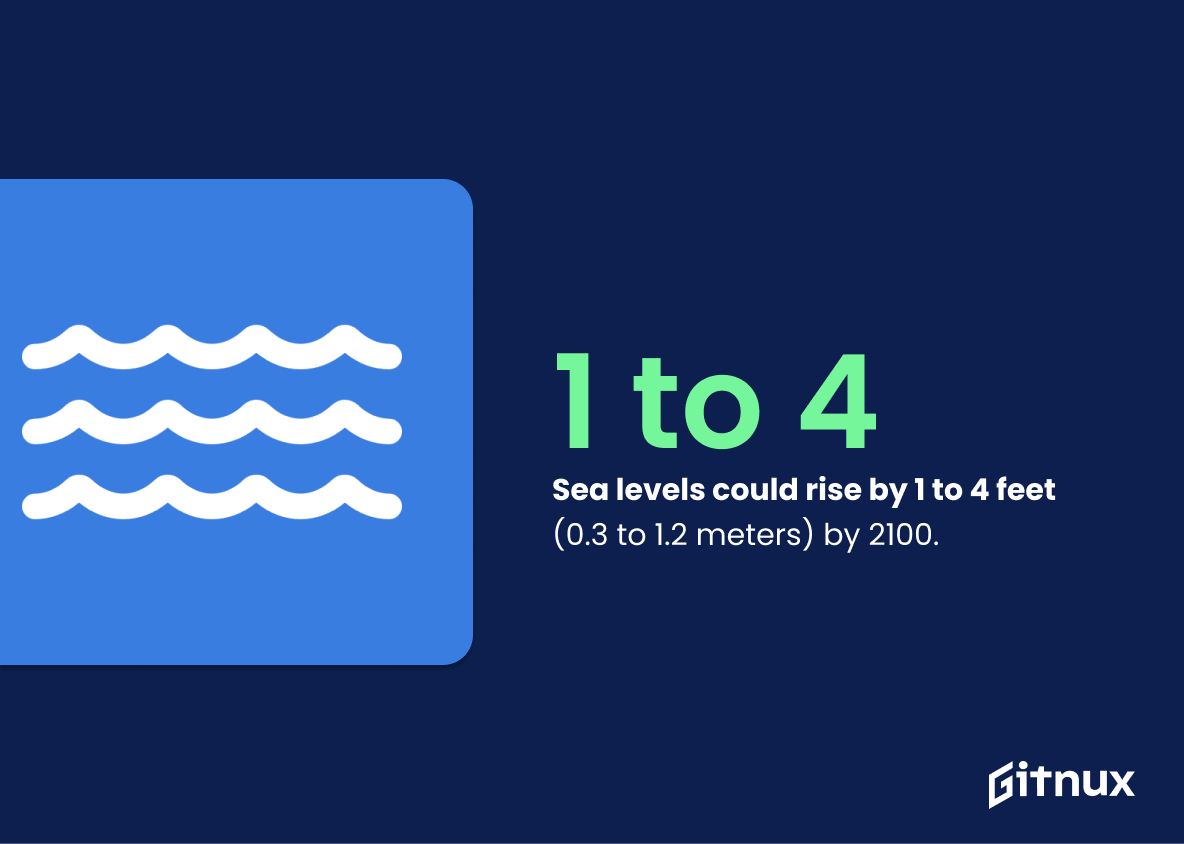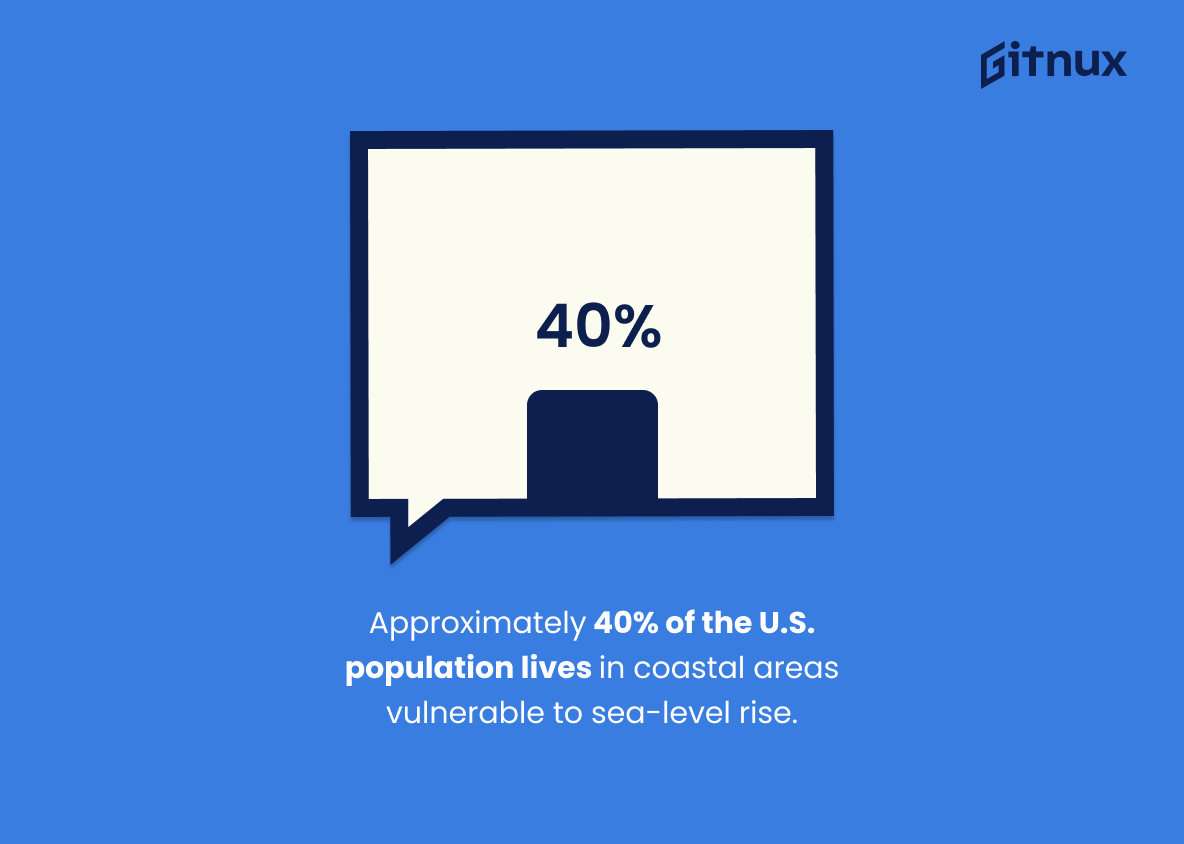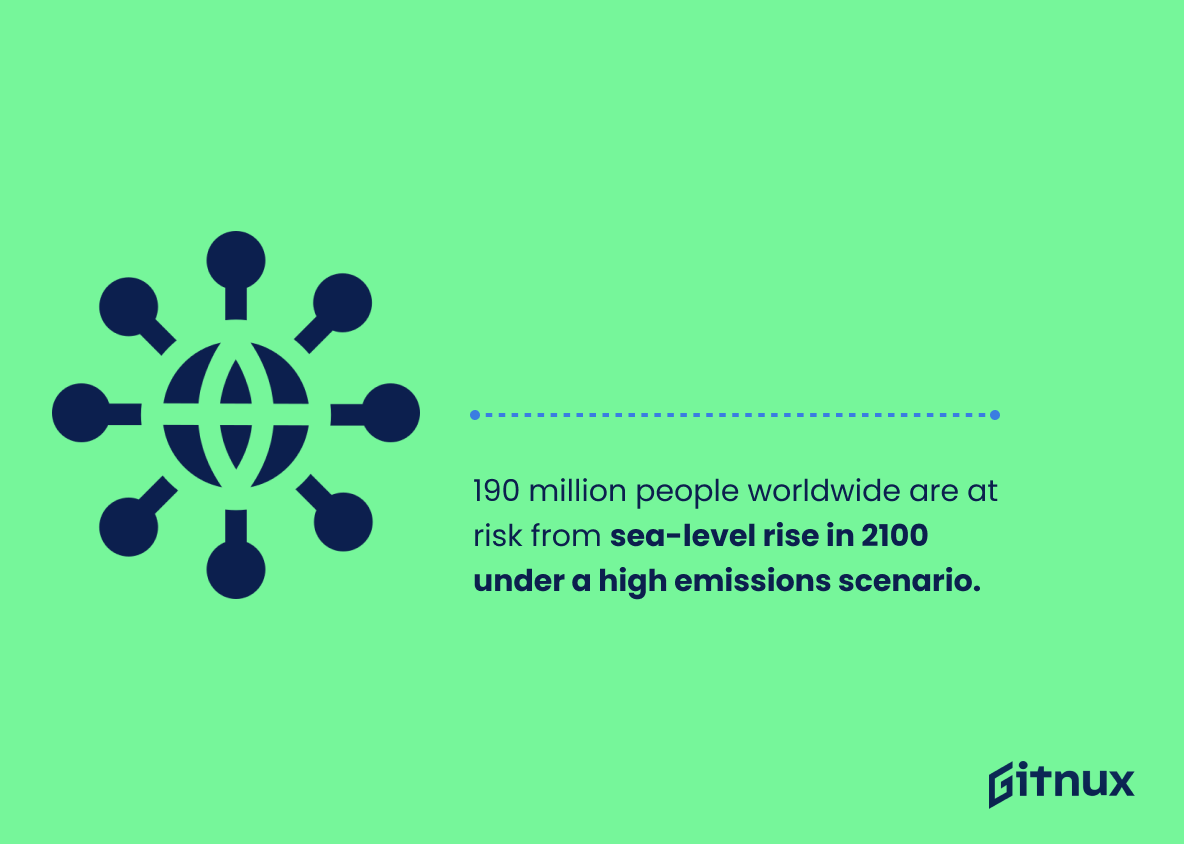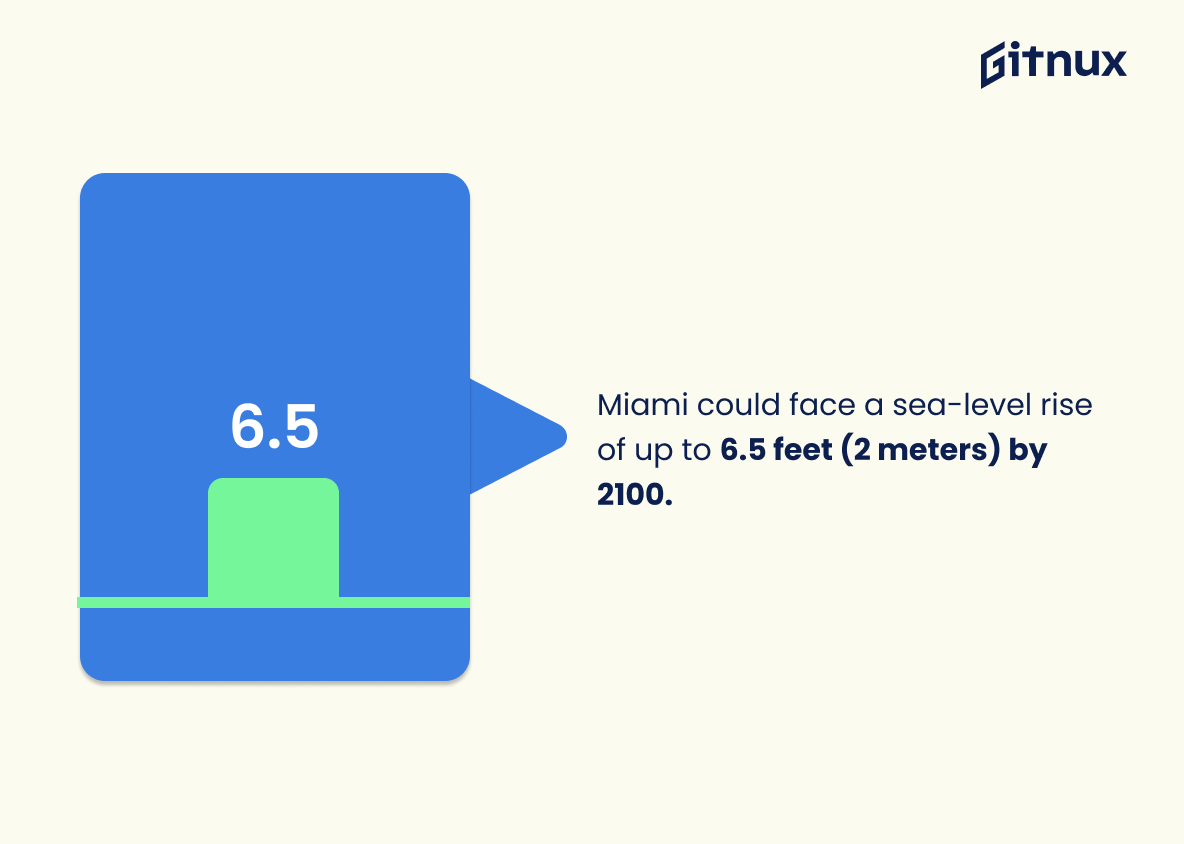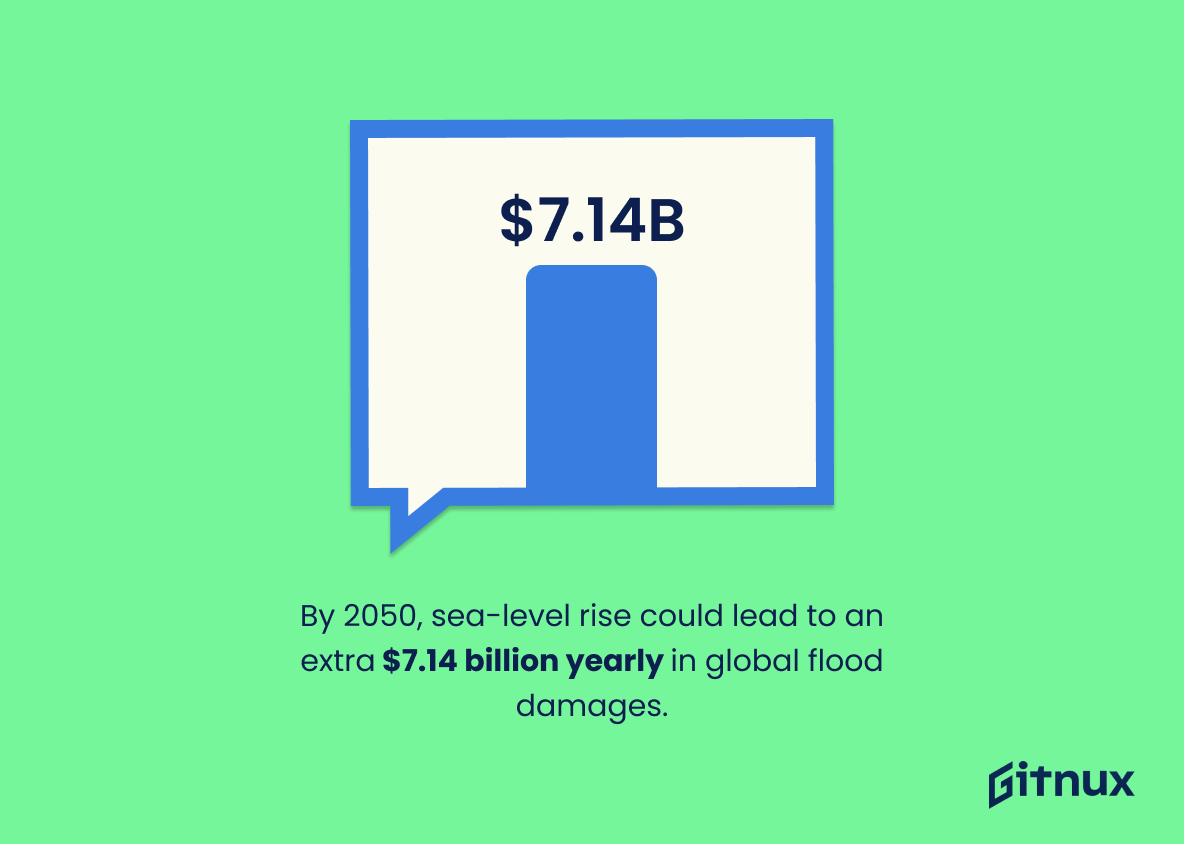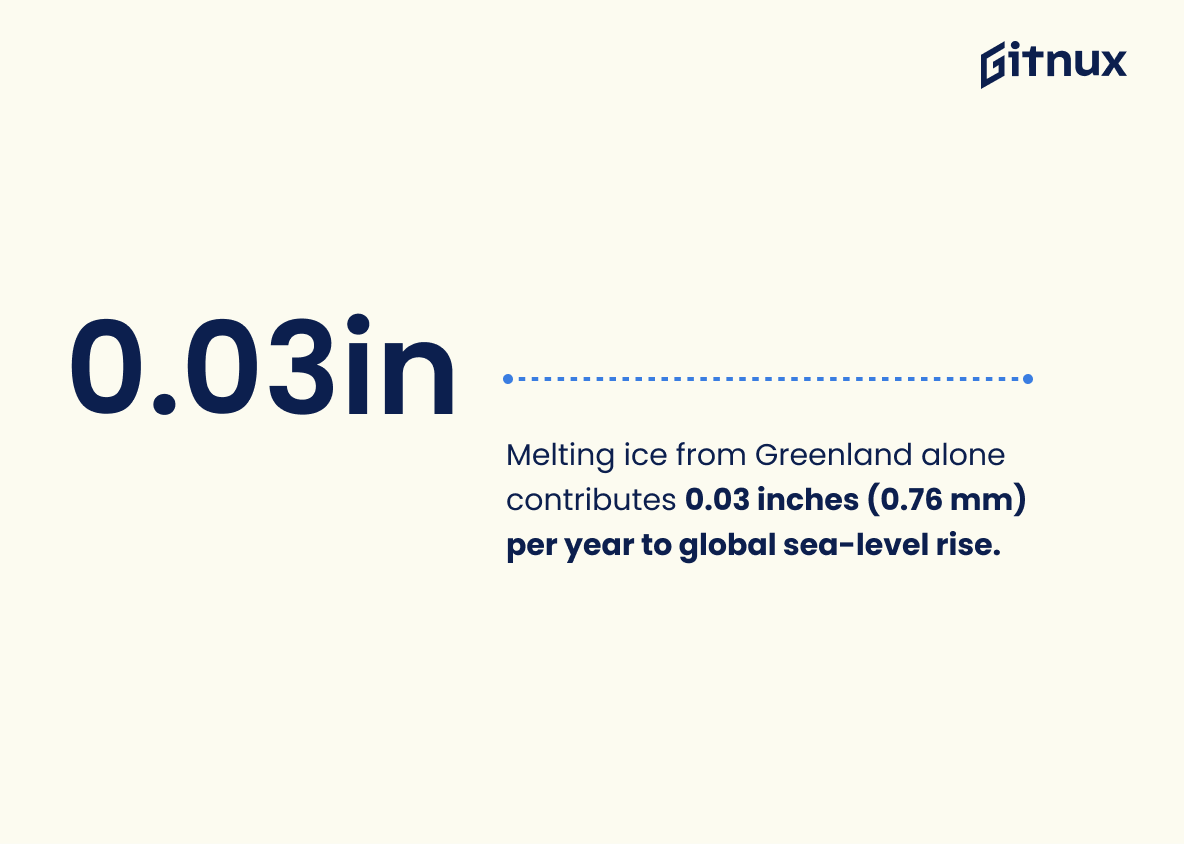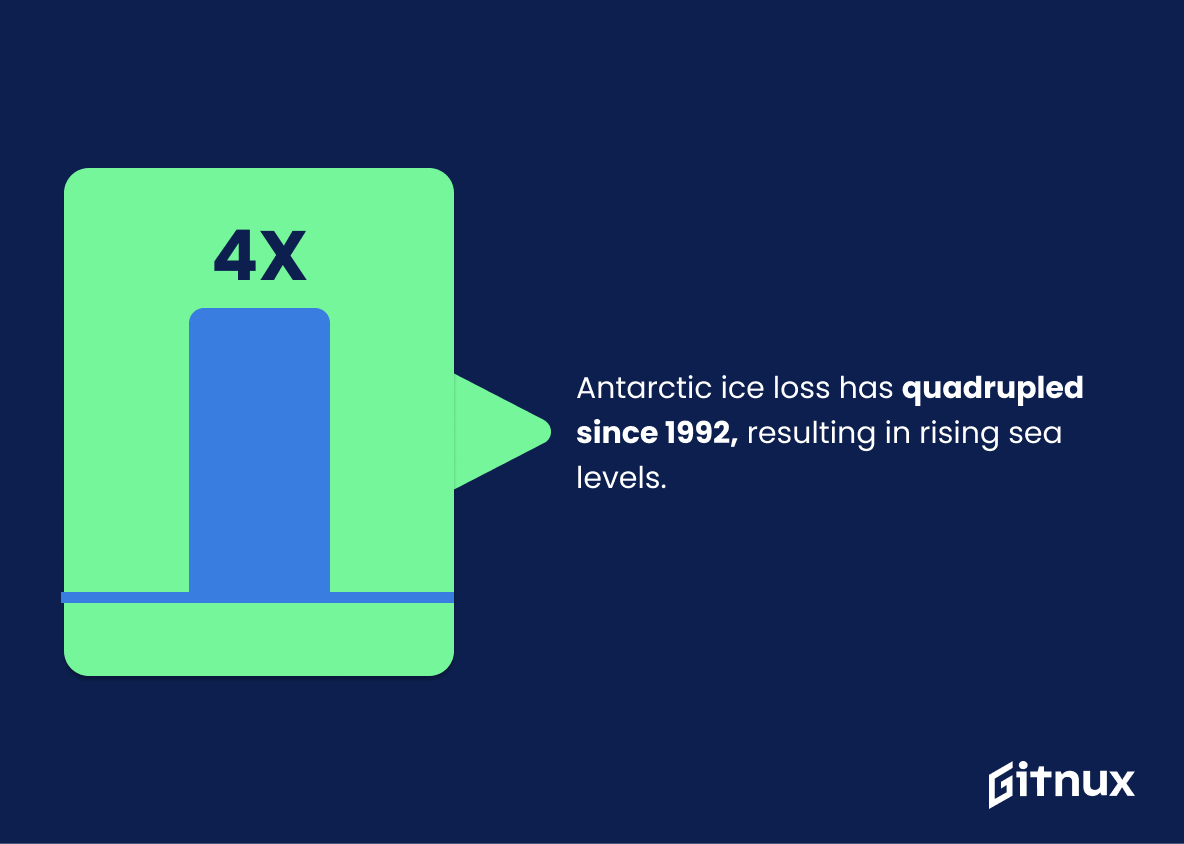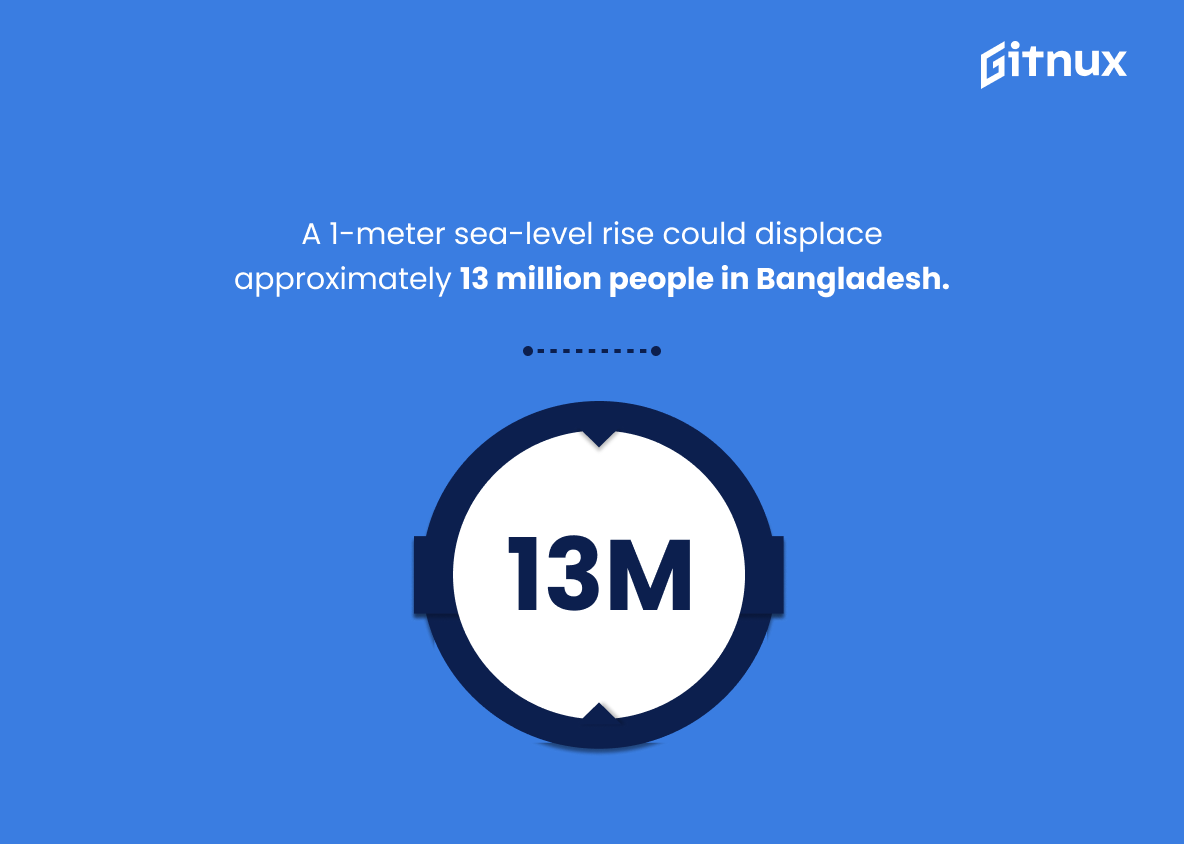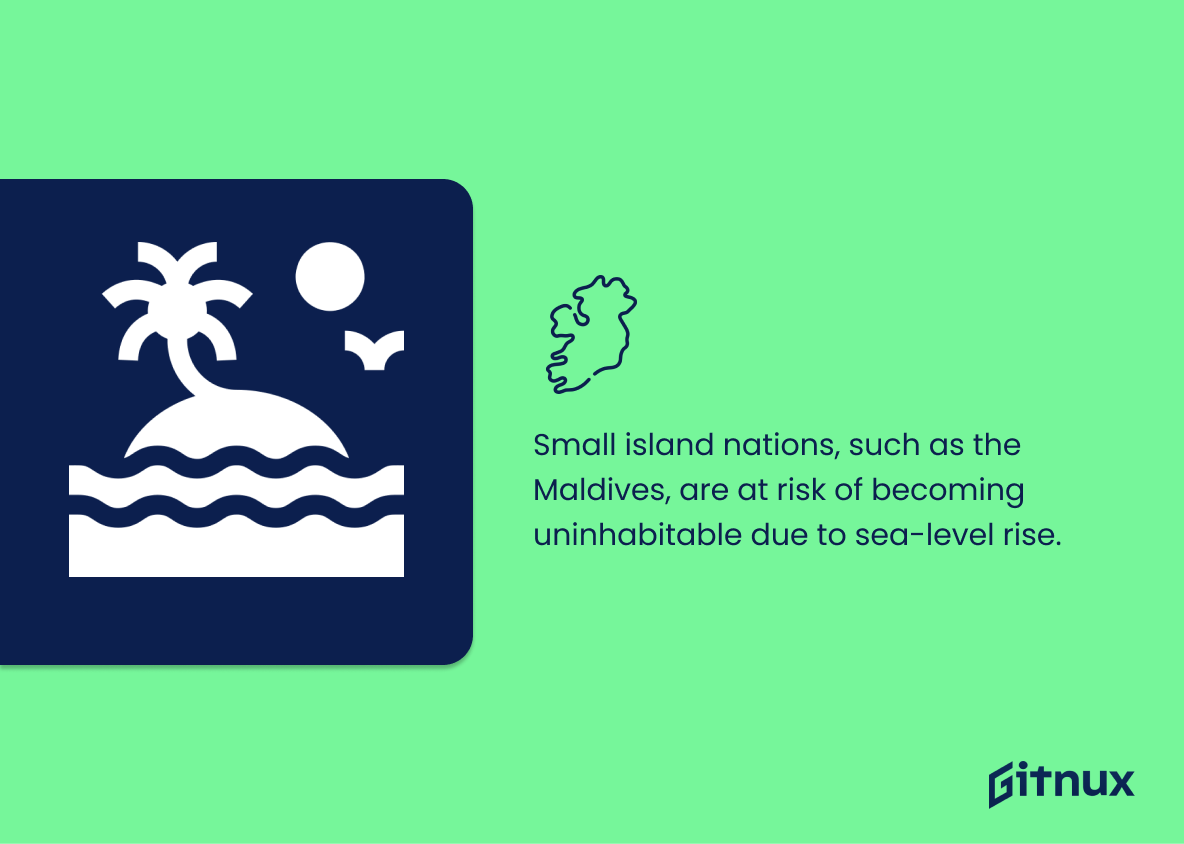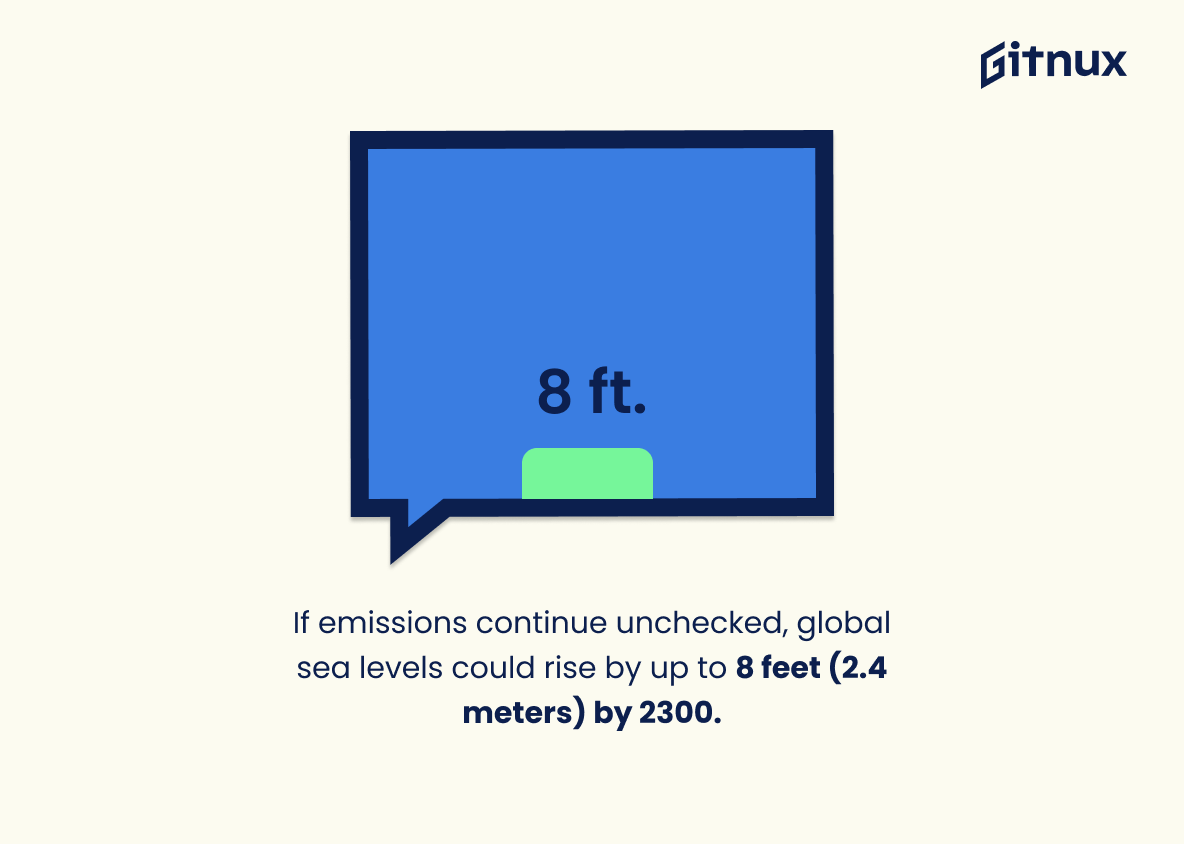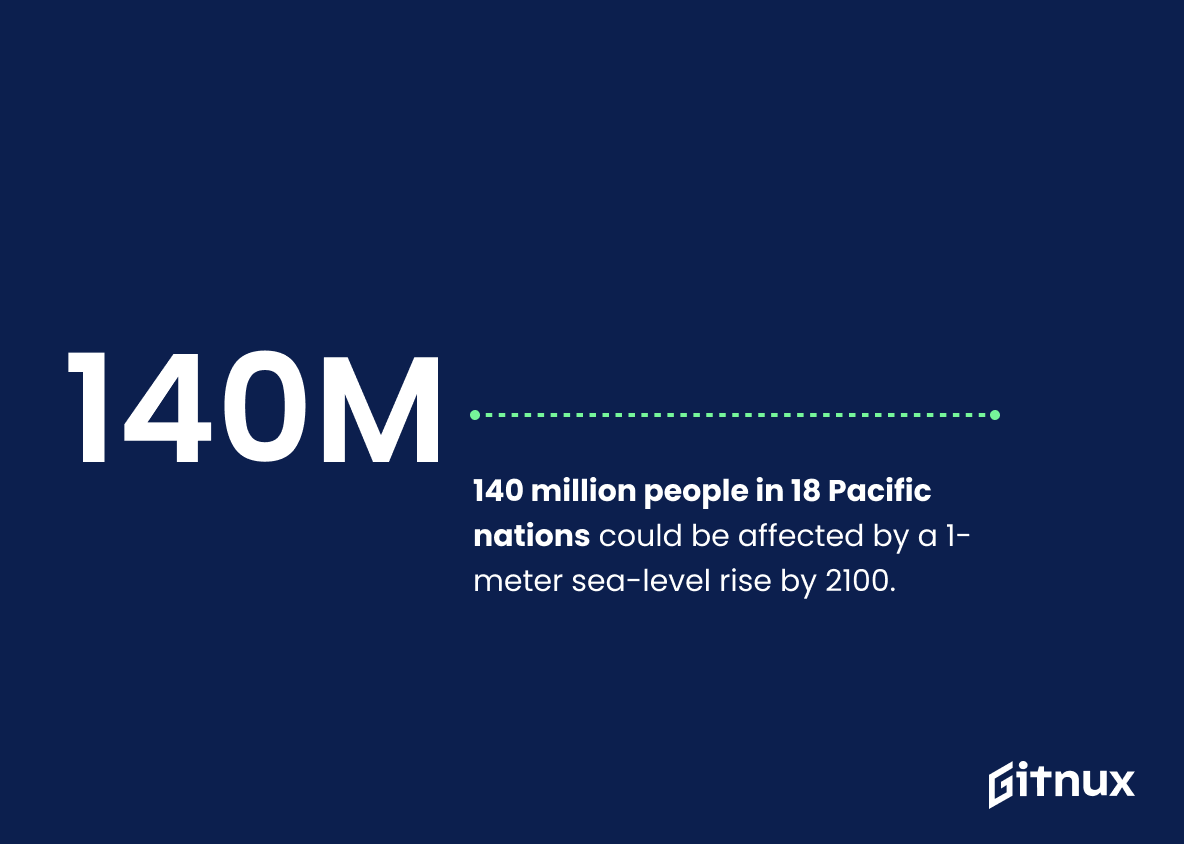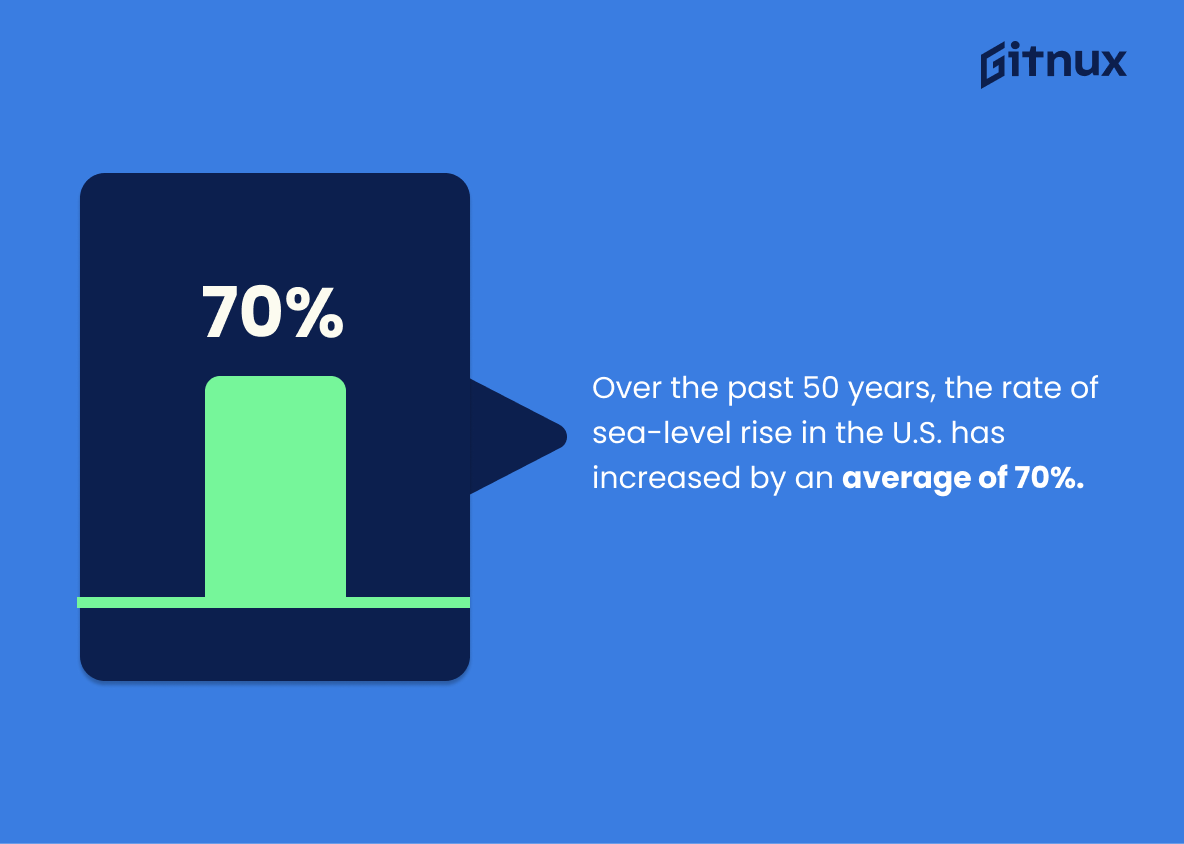Sea level rise is one of the most pressing issues facing our planet today. According to recent statistics, global sea levels have risen by 8 inches (20 cm) since 1880 and within the past 25 years, the rate of sea-level rise has doubled to about 3.3 millimeters per year. Sea levels could potentially reach 1 to 4 feet (0.3 to 1.2 meters) by 2100, putting approximately 40% of U.S population living in coastal areas at risk from flooding and other disasters associated with rising seas – not just in America but worldwide too; 190 million people are already estimated as being vulnerable under a high emissions scenario for 2100 alone.
The situation looks even more dire when we look closer at specific regions: Miami could face up 6.5 feet (2 meters), New York City between 10 and 33 inches (25 and 84 cm), while Bangladesh may be forced into displacement due to a single meter increase in water height – this would affect 13 million people there alone. Small island nations such as Maldives are also particularly threatened by rising waters which can make them uninhabitable over time if no action is taken soon enough against climate change causing factors like greenhouse gas emissions that contribute significantly towards melting ice sheets around Antarctica or Greenland where 0.03 inches (076 mm) per year adds up globally on average each year according to estimates made recently..
By 2050 it’s predicted that 230-480 million people will be affected across all continents due mainly because oceanic temperatures continue increasing faster than expected leading us towards an alarming future where US property damages caused solely through sea level rises might exceed $1 trillion dollars annually whereas flood damage costs globally add another $7 billion every 12 months until then unless something changes drastically now before its too late.
Sea Level Rise Statistics Overview
Sea levels could rise by 1 to 4 feet (0.3 to 1.2 meters) by 2100.
This statistic is a stark reminder of the potential consequences of sea level rise. With a rise of 1 to 4 feet, coastal cities and towns could be submerged, leading to displacement of millions of people and destruction of vital ecosystems. This statistic serves as a call to action to take steps to mitigate the effects of climate change and protect our planet.
Approximately 40% of the U.S. population lives in coastal areas vulnerable to sea-level rise.
This statistic is a stark reminder of the potential consequences of sea-level rise. With 40% of the population living in coastal areas, the effects of rising sea levels could be devastating for millions of people. It is a sobering reminder of the need to take action to mitigate the effects of climate change.
190 million people worldwide are at risk from sea-level rise in 2100 under a high emissions scenario.
This statistic is a stark reminder of the potential consequences of unchecked emissions. It paints a vivid picture of the sheer number of people who could be affected by sea-level rise in the future, and serves as a powerful call to action to reduce emissions and mitigate the effects of climate change.
Miami could face a sea-level rise of up to 6.5 feet (2 meters) by 2100.
This statistic is a stark reminder of the potential consequences of sea level rise. With a rise of 6.5 feet, Miami could be facing catastrophic flooding and displacement of its citizens. This statistic serves as a warning to take action now to mitigate the effects of climate change and sea level rise.
New York City could see sea-level rise between 10 and 33 inches (25 and 84 cm) by 2080.
This statistic is a stark reminder of the potential consequences of sea-level rise in New York City. With a rise of up to 84 cm, the city could be facing a significant challenge in the coming decades. This could mean flooding of low-lying areas, increased coastal erosion, and other impacts on the city’s infrastructure and environment. It is a sobering reminder of the need to take action now to mitigate the effects of climate change.
A 1 meter sea-level rise could cost the United States $1 trillion in property damages.
This statistic is a stark reminder of the immense financial burden that sea-level rise could impose on the United States. With a 1 meter rise, the potential for property damage is staggering, and it serves as a warning of the potential economic consequences of inaction.
Sea-level rise could cause an additional $7.14 billion per year in flood damages globally by 2050.
This statistic is a stark reminder of the potential economic consequences of sea-level rise. By 2050, the cost of flood damages could skyrocket to an additional $7.14 billion per year, a figure that is sure to have a significant impact on global economies. This statistic serves as a warning to take action now to mitigate the effects of sea-level rise before it is too late.
Melting ice from Greenland alone contributes 0.03 inches (0.76 mm) per year to global sea-level rise.
This statistic is a stark reminder of the tangible effects of climate change. Even a seemingly small amount of melting ice from Greenland can have a significant impact on global sea-level rise. It is a sobering reminder that we must take action to reduce our carbon emissions and protect our planet.
Antarctic ice loss has quadrupled since 1992, resulting in rising sea levels.
This statistic is a stark reminder of the devastating effects of climate change. It shows that the rate of Antarctic ice loss has increased dramatically since 1992, leading to a rise in sea levels that could have catastrophic consequences for coastal communities and ecosystems around the world. It is a stark reminder that we must take urgent action to address the climate crisis and protect our planet.
A 1-meter sea-level rise could displace approximately 13 million people in Bangladesh.
This statistic is a stark reminder of the devastating impact that sea level rise can have on human populations. It highlights the fact that millions of people in Bangladesh could be forced to leave their homes and communities due to the effects of climate change. This statistic serves as a powerful reminder of the urgent need to take action to mitigate the effects of sea level rise and protect vulnerable populations.
Small island nations, such as the Maldives, are at risk of becoming uninhabitable due to sea-level rise.
This statistic is a stark reminder of the devastating effects of sea-level rise. It highlights the urgency of the situation, as small island nations are particularly vulnerable to the impacts of climate change. The Maldives, for example, is a low-lying nation that could be completely submerged if sea levels continue to rise. This statistic serves as a warning to us all that we must take action now to protect our planet and its inhabitants.
If emissions continue unchecked, global sea levels could rise by up to 8 feet (2.4 meters) by 2300.
This statistic is a stark reminder of the potential consequences of unchecked emissions. If left unchecked, the rise in global sea levels could have a devastating impact on coastal communities and ecosystems around the world. The projected 8-foot rise in sea levels by 2300 is a sobering reminder of the urgent need to take action to reduce emissions and mitigate the effects of climate change.
Approximately 140 million people in 18 countries bordering the Pacific Ocean could be affected by a 1-meter sea level rise by 2100.
This statistic is a stark reminder of the potential consequences of sea level rise. It paints a vivid picture of the sheer number of people who could be affected by a 1-meter rise in sea level by 2100, and serves as a powerful reminder of the urgent need to take action to mitigate the effects of climate change.
Over the past 50 years, the rate of sea-level rise in the U.S. has increased by an average of 70%.
This statistic is a stark reminder of the reality of sea-level rise in the U.S. over the past half-century. It highlights the fact that the rate of sea-level rise has been steadily increasing, and that this trend is likely to continue in the future. This is an important statistic to consider when discussing the potential impacts of sea-level rise on coastal communities and ecosystems.
A 1-meter sea-level rise could reduce the global population living on land by up to 2.7% by 2100.
This statistic is a stark reminder of the potential consequences of sea level rise. It highlights the fact that a 1-meter rise in sea level could displace millions of people around the world, leading to a significant decrease in the global population living on land by 2100. This is a sobering thought that should not be taken lightly.
By 2100, the oceans may rise by as much as 6.6 feet (2 meters) due to the melting of the Antarctic ice sheet.
This statistic is a stark reminder of the potential consequences of climate change. If the Antarctic ice sheet continues to melt, it could lead to a dramatic rise in sea levels, with devastating effects on coastal communities and ecosystems. This statistic serves as a warning of the urgent need to take action to reduce emissions and mitigate the effects of climate change.
Sea-level rise in the Indian Ocean could exceed 80 centimeters per year by 2100, impacting densely populated coastal areas.
This statistic is a stark reminder of the potential consequences of sea-level rise in the Indian Ocean. With densely populated coastal areas facing the risk of being inundated by rising waters, it is a stark reminder of the urgent need to take action to mitigate the effects of climate change.
Conclusion
The statistics presented in this blog post demonstrate the alarming rate of sea-level rise and its potential impacts on coastal communities around the world. Global sea levels have risen by 8 inches (20 cm) since 1880, with a doubling of that rate over the past 25 years to 3.3 millimeters per year. Sea levels could rise by 1 to 4 feet (0.3 to 1.2 meters) by 2100, putting 40% of Americans living in vulnerable coastal areas at risk from flooding and other disasters associated with rising seas. Worldwide, 190 million people are projected to be affected under high emissions scenarios while 230 – 480 million people may face consequences due to sea level rise by 2050 alone; these numbers will only increase if emissions continue unchecked as global temperatures warm further into the future leading up 2300 when oceans may reach 6.6 feet (2 meters). The effects vary regionally: Miami is expected see a maximum 6 foot 5 inch (2 meter) increase while New York City faces 10 – 33 inches (25 – 84 cm), Bangladesh 13 million displaced persons, small island nations such as Maldives uninhabitable conditions and Indian Ocean 80 centimeters per year increases impacting densely populated areas all before 2100 arrives.. These figures represent an immense economic burden for many countries including $1 trillion property damages for US citizens alone plus additional annual flood damage costs globally estimated at $7 billion dollars annually come 2050 should current trends persist without intervention or adaptation measures taken now . It is clear that urgent action must be taken immediately if we hope mitigate some of these devastating outcomes caused directly from human induced climate change through our continued reliance on fossil fuels which has already begun irreversibly altering Earth’s delicate balance between land and ocean ecosystems worldwide
References
0. – https://www.theguardian.com
1. – https://www.ipcc.ch
2. – https://www.climate.nasa.gov
3. – https://www.nationalgeographic.com
4. – https://www.climate.gov
5. – https://www.nyc.gov
6. – https://www.smithsonianmag.com
7. – https://www.pnas.org
8. – https://www.journals.plos.org
9. – https://www.link.springer.com
10. – https://www.noaa.gov
11. – https://www.adb.org
12. – https://www.usgs.gov
13. – https://www.nature.com
14. – https://www.pubmed.ncbi.nlm.nih.gov
15. – https://www.sealevelrise.org
